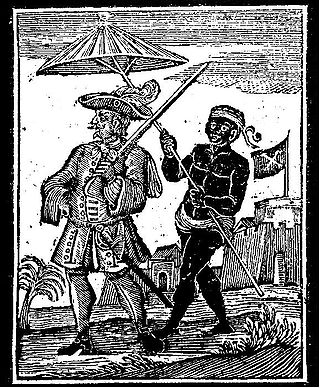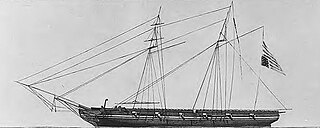Related Research Articles

Edward Teach, better known as Blackbeard, was an English pirate who operated around the West Indies and the eastern coast of Britain's North American colonies. Little is known about his early life, but he may have been a sailor on privateer ships during Queen Anne's War before he settled on the Bahamian island of New Providence, a base for Captain Benjamin Hornigold, whose crew Teach joined around 1716. Hornigold placed him in command of a sloop that he had captured, and the two engaged in numerous acts of piracy. Their numbers were boosted by the addition to their fleet of two more ships, one of which was commanded by Stede Bonnet, but Hornigold retired from piracy toward the end of 1717, taking two vessels with him.

William Kidd, also known as Captain William Kidd or simply Captain Kidd, was a Scottish privateer. Conflicting accounts exist regarding his early life, but he was likely born in Dundee and later settled in New York City. By 1690, Kidd had become a highly successful privateer, commissioned to protect English interests in North America and the West Indies.

The Darien scheme was an unsuccessful attempt, backed largely by investors of the Kingdom of Scotland, to gain wealth and influence by establishing New Caledonia, a colony in the Darién Gap on the Isthmus of Panama, in the late 1690s. The plan was for the colony, located on the Gulf of Darién, to establish and manage an overland route to connect the Pacific and Atlantic Oceans. The backers knew that the first sighting of the Pacific Ocean by Vasco Núñez de Balboa was after crossing the isthmus through Darién. The expedition also claimed sovereignty over "Crab Isle" in 1698, yet sovereignty was short-lived. The attempt at settling the area did not go well; more than 80 percent of participants died within a year, and the settlement was abandoned twice.

Stede Bonnet was an English pirate who was known as the Gentleman Pirate because he was a moderately wealthy landowner before turning to a life of crime. Bonnet was born into a wealthy English family on the island of Barbados, and inherited the family estate after his father's death in 1694. Despite his lack of sailing experience, Bonnet decided he should turn to piracy in the spring of 1717. He bought a sailing vessel, the Revenge, and travelled with his paid crew along the Eastern Seaboard of what is now the United States, capturing other vessels and burning other Barbadian ships.

Henry Every, also known as Henry Avery, sometimes erroneously given as Jack Avery or John Avery, was an English pirate who operated in the Atlantic and Indian oceans in the mid-1690s. He probably used several aliases throughout his career, including Benjamin Bridgeman, and was known as Long Ben to his crewmen and associates.

Admiral Thomas Gordon was a commodore of the Royal Scots Navy and Admiral of the Imperial Russian Navy.

John Halsey was a British privateer and later a pirate who was active in the Atlantic and Indian Oceans during the early 18th century. Although much of his life and career is unknown, he is recorded in A General History of the Pyrates, which states "He was brave in his Person, courteous to all his Prisoners, lived beloved, and died regretted by his own People. His Grave was made in a garden of watermelons, and fenced in with Palisades to prevent his being rooted up by wild Hogs."

John Bowen was a pirate of Créole origin active during the Golden Age of Piracy. He sailed with other famous contemporaries, including Nathaniel North and George Booth, who was his captain when he was a crewman aboard the Speaker. Over a four-year period, Bowen took about £170,000 in goods and coinage and retired to Bourbon for a brief period of time before his death in 1704.
See also 1703 in piracy, other events in 1704, 1705 in piracy, and Timeline of piracy.
See also 1701 in piracy, other events in 1702, 1703 in piracy, and Timeline of piracy.
See also 1702 in piracy, other events in 1703, 1704 in piracy, and Timeline of piracy.
See also 1704 in piracy, other events in 1705, 1706 in piracy, and Timeline of piracy.
Events from the year 1705 in the Kingdom of Scotland.
Piracy off the coast of Somalia occurs in the Gulf of Aden, Guardafui Channel, and Somali Sea, in Somali territorial waters and other surrounding places and has a long troubled history with different perspectives from different communities. It was initially a threat to international fishing vessels during the early 2000s, only to rapidly escalate and expand to international shipping during the War in Somalia (2006–2009).
On September 2, 2008, the French yacht Carré d'As IV and its two crew were captured in the Gulf of Aden by seven armed Somali pirates, who demanded the release of six pirates captured in the April MY Le Ponant raid and over one million dollars in ransom. On September 16, 2008, on the orders of President Nicolas Sarkozy, French special forces raided and recovered the yacht, rescued the two hostages, killed one pirate, and captured the other six. The pirates were flown to France to stand trial for piracy and related offenses; ultimately, five of them were convicted and sentenced to four to eight years in prison, while a sixth was acquitted. The incident marked the second French counter-piracy commando operation of 2008, as well as the first French trial of Somali pirates.

The Maersk Alabamahijacking began on 8 April 2009, when four pirates in the Somali Basin seized the Danish/U.S. cargo ship Maersk Alabama at a distance of 240 nautical miles southeast of Eyl, Somalia. The siege ended after a rescue effort by the United States Navy on April 12.

Abduwali Abdulkadir Muse is a Somali pirate. He is the sole survivor of four pirates who hijacked the MV Maersk Alabama in April 2009 and then held Captain Richard Phillips for ransom. On 16 February 2011, Muse was convicted and sentenced to 33 years and 9 months in U.S. federal prison.

The West Indies Anti-Piracy Operations were a series of military operations and engagements undertaken by the United States Navy against pirates in and around the Antilles. Between 1814 and 1825, the American West Indies Squadron hunted pirates on both sea and land, primarily around Cuba and Puerto Rico. After the capture of Roberto Cofresi in 1825, acts of piracy became rare, and the operation was considered a success, although limited occurrences went on until slightly after the start of the 20th century.

The Atlantic World refers to the period between European colonization of the Americas (1492-) and the early nineteenth century. Piracy became prevalent in this era because of the difficulty of policing this vast area, the limited state control over many parts of the coast, and the competition between different European powers. The best known pirates of this era are the Golden Age Pirates who roamed the seas off the coasts of North America, Africa, and the Caribbean.

The Proclamation for Suppressing of Pirates was a royal proclamation issued by George I of Great Britain on 5 September 1717. It promised a pardon for acts of piracy committed before the following 5 January to those pirates who surrendered themselves to the correct authority before a deadline. Originally, the surrender had to occur on or before 5 September 1718; this was later extended by a second proclamation to 1 July 1719.
References
- ↑ Menefee, Samuel P. (2004), "Greene, Thomas", Oxford Dictionary of National Biography, vol. 23, London: Oxford University Press, pp. 532–33.
- ↑ Anonymous (1720), Tryals for High Treason and Other Crimes with Proceedings and Impeachments for Three Hundred Years Past, vol. 4, London: Timothy Goodwin, pp. 448–463.
- ↑ Anonymous (1705), The Tryal Of Captain Thomas Green and his Crew: For Piracy, Robbery and Murder, Edinburgh: Anderson, p. 42.
- 1 2 Trevelyan, George Macaulay (1932), England Under Queen Anne: Ramilles and the Union with Scotland, London: Longmans Green and Co., pp. 249–256.
- ↑ Lang, Andrew (1904). Historical Mysteries. London: Smith, Elder, & Company. pp. 210–211. ISBN 978-3-8496-7426-7 . Retrieved 28 December 2021.
